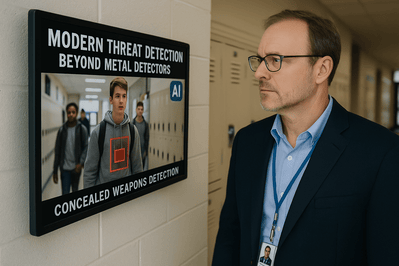
For decades, many schools have leaned on metal detectors as their primary threat detection method. While they’ve served a purpose—especially in urban and high-risk settings—times have changed. Today’s threats are more complex, and technology has evolved.
Now, school administrators and safety teams are asking a bigger question:
Is there a better way to keep campuses secure without creating a fortress-like atmosphere?
The answer is yes—and it involves smarter, more adaptable tools that go far beyond the traditional beeping at the door.
l
l
Why Rethink Traditional Metal Detectors?
Metal detectors are reactive. They can detect metallic objects but can’t identify intent, context, or behavior. More importantly, they’re often:
-
Time-consuming during high-traffic periods
-
Easy to circumvent
-
Known to create anxiety or discomfort for students
They also can’t help once someone is already inside. That’s a major gap when you consider that many security incidents happen well beyond the front entrance.
If your school is still relying solely on metal detectors, you may be missing out on tools that offer earlier warning, better data, and more flexible response options.
l
l
What Does “Modern Threat Detection” Actually Mean?
Modern threat detection in schools is about more than spotting a weapon. It’s about identifying patterns, behaviors, and risks before they escalate into harm.
Here are the key technologies making that possible:
1. Concealed Weapons Detection Systems (CWD)
These systems use AI and advanced sensor fusion (like millimeter-wave imaging and magnetic field sensors) to detect weapons without requiring a bag search or physical scan.
-
Faster than metal detectors
-
Less invasive and more discreet
-
Ideal for entrances, gyms, auditoriums, and events
CWD platforms can screen hundreds of students per hour with far less disruption.
2. Behavioral Video Analytics
Traditional cameras record what happened. But today’s AI-powered video surveillance systems can:
-
Flag aggressive behavior or loitering
-
Detect unauthorized access
-
Monitor crowd dynamics in real time
This gives security teams a heads-up before a fight breaks out or an area becomes unsafe—not just footage to review afterward.
3. Gunshot Detection and Audio Analytics
These systems can automatically recognize the sound of gunfire, breaking glass, or even shouting. Within seconds, they alert administrators and law enforcement.
This is especially useful in large campuses or buildings where it’s difficult to pinpoint the source of a threat quickly.
4. Integrated Access Control Systems
By combining entry management with real-time monitoring, schools can:
-
Lock down zones instantly
-
Restrict entry based on role or time of day
-
Receive alerts when doors are propped or forced open
In many cases, these systems can be linked to emergency alert platforms for automatic response.
l
l
Balancing Security With Student Wellbeing
One concern many educators have is this:
How do we implement stronger security measures without making students feel like they’re in a prison?
Modern threat detection systems help solve that dilemma. Because they’re more discreet, automated, and data-driven, they allow schools to:
-
Reduce bottlenecks at entrances
-
Avoid the stigma of visible “scanning” zones
-
Focus attention on high-risk behaviors, not high-stress environments
It’s not about adding more barriers—it’s about building smarter, quieter protection into everyday school life.
l
l
What School Safety Looks Like in 2025 and Beyond
The best school safety strategies today are layered, integrated, and proactive. It’s not enough to stop threats at the door—you need tools that identify and respond to risks throughout the entire school day.
Modern threat detection includes:
-
Smart cameras and access points that talk to each other
-
Alert systems that notify the right people in seconds
-
Analytics that help you improve safety over time
If your current tools don’t do that, it may be time for a serious upgrade.
l
l
Final Thoughts
Metal detectors aren’t obsolete—but they are no longer enough. To truly protect students and staff, schools need to think beyond the front entrance and embrace tools that provide faster insight, broader coverage, and a more flexible response.
The good news? You don’t have to do it alone. SSP partners with schools to design custom security solutions that fit your campus, your community, and your budget.
Looking to modernize your threat detection system?
Contact us today to schedule a safety assessment or explore integrated school security options.


